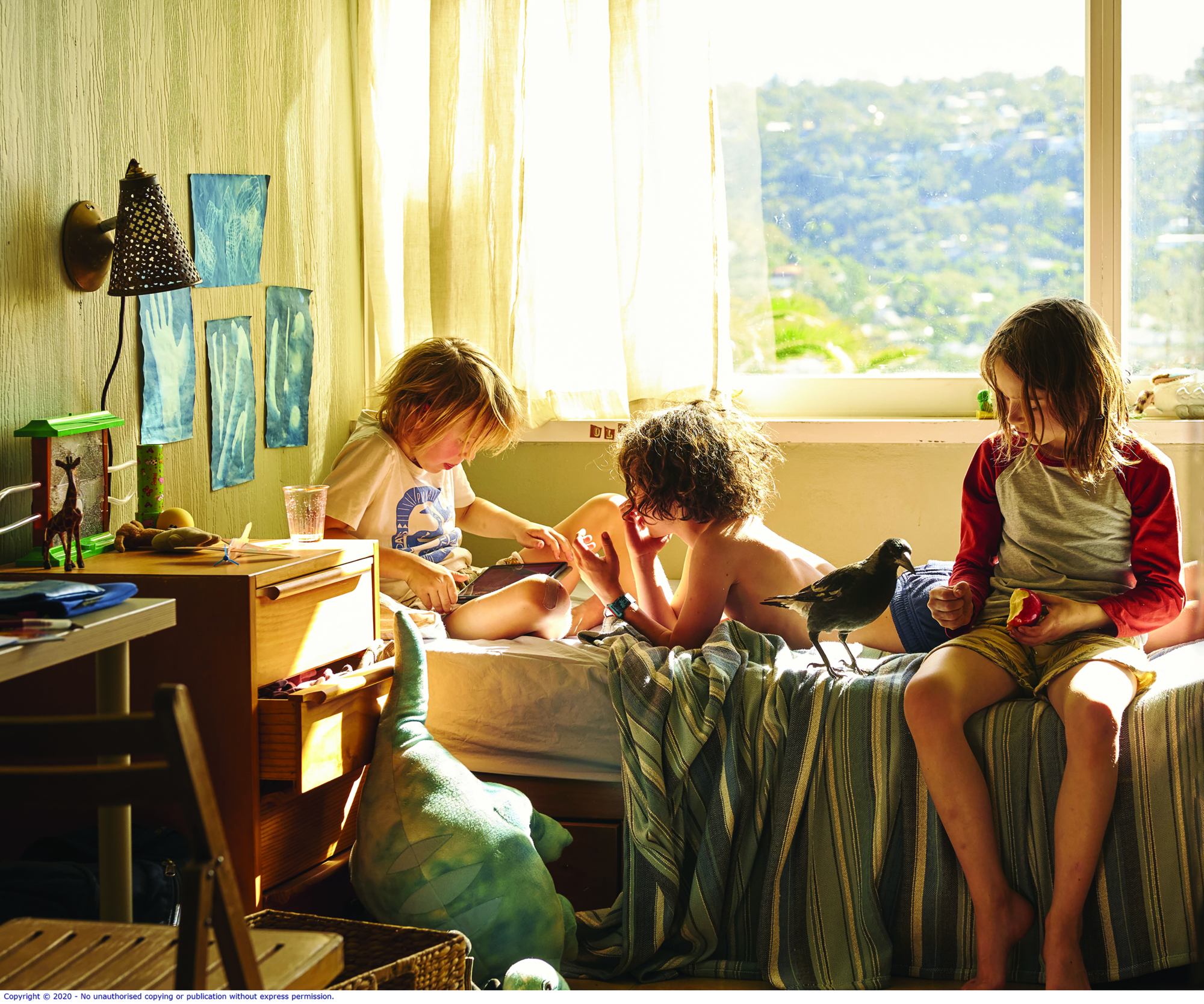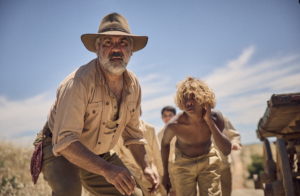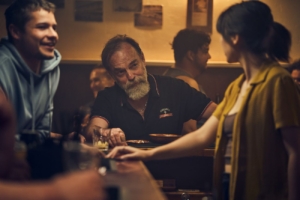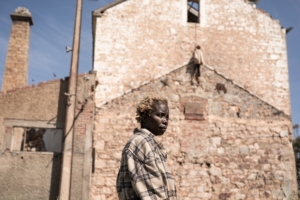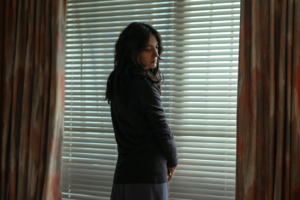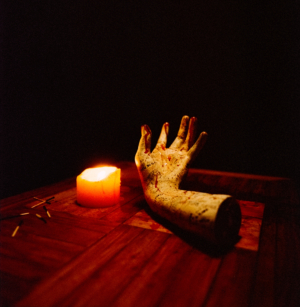For years before making Penguin Bloom (2020), director Glendyn Ivin had wanted to make a film about animals. ‘When I was a kid, I loved films with animals in them – and it’s stuck with me ever since,’ he says.
Storm Boy [Henri Safran, 1976] has always been a touchstone for me. I saw it at the cinema when I was around seven years old. I was so moved then, and I still am. I also loved Ring of Bright Water [Jack Couffer, 1969], a film about an otter set in Scotland. Animals can’t speak, and so audiences automatically have a different kind of relationship with them; we naturally project what they’re thinking or feeling.
After discussing this interest with Bec Smith, his agent in the United States, Ivin received a book in the mail, Penguin Bloom: The Odd Little Bird Who Saved a Family. It told the true story of Samantha Bloom, an avid surfer and traveller who, while on a family holiday in Thailand in 2013, had fallen from a balcony and broken her spine in two places – then woken to discover she would be paralysed from the chest down for life. On returning to her home in Sydney’s Northern Beaches, Bloom fell into a depression that only began to abate a year later when her three sons, Rueben, Noah and Oli, brought home a wounded baby magpie named Penguin, who joined the family – and changed everything.[1]See Gail Williams, ‘The Inspirational Story of How Penguin the Magpie Saved Sam Bloom After a Horrendous Fall’, Sunday Times Magazine, 26 February 2018, available at <https://www.perthnow.com.au/lifestyle/stm/stm-the-inspirational-story-of-how-penguin-the-magpie-saved-sam-bloom-after-a-horrendous-fall-ng-b88749362z>, accessed 17 March 2021.
Not long after reading the book, Ivin was living in Glasgow, where he had been working on The Cry, a 2018 UK–Australian television miniseries about a couple whose four-month-old baby goes missing outside a shop in coastal Victoria:
I’d been in Glasgow for eight months when Bec sent me an email about transforming Penguin Bloom into a film. I’d been doing a lot of work for television – The Cry, Seven Types of Ambiguity, Safe Harbour – and it had all been pretty dark: stories about missing children, dead children. So I thought, ‘Yes, I’m ready to work on something that, even though it involves darkness, ends with hope and light.’
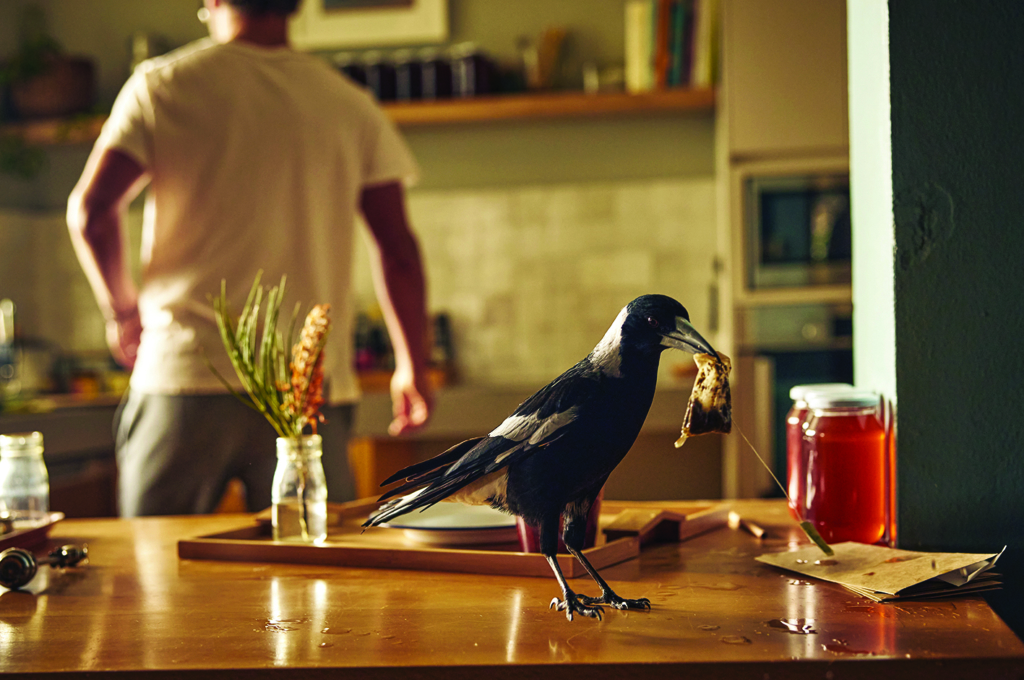
In adapting the book, Ivin explains that he adopted a reductive approach:
I’ve always loved simplicity – drilling down to find out what the true origin of a story is. The first stage of my filmmaking process is always to cut, cut, cut away, until you’re left with only the basic elements […] I believe the most important thing, in adapting a book, is not getting too caught up in getting the narrative right, beat by beat, but in capturing how it makes readers feel – in translating the tone and the feeling and the essence of the characters.
With Penguin Bloom, this process was perhaps easier than with other books. Unlike conventional memoirs, Penguin Bloom: The Odd Little Bird Who Saved a Family – authored by Bloom’s husband, Cameron (who is also a professional photographer), and Bradley Trevor Greive, author of The Blue Day Book – is like a picture book for adults, comprising beautifully-shot photographs and accompanied by just one or two sentences on each page. The film embraces this minimalism, sticking to a straightforward narrative – the accident, its impact on the Blooms’ life when they return to Australia and the arrival of Penguin – all the while resisting the temptation of complicated subplots. Consequently, the focus is on the emotional journey of Sam (Naomi Watts) and her evolving relationships, particularly with Noah (Griffin Murray-Johnston), Cameron (Andrew Lincoln) and Penguin. Ivin describes it thus:
Usually, in the editing process, you create tension with one character until you reach the point that they’re in trouble, then cut away to another character in another location. But Penguin Bloom is on the rails from the moment it begins, and stays on them until the end. There aren’t multiple characters to cut away to; instead, the balls you’re juggling are the various aspects of Samantha’s life.
Even within this framework, Ivin privileges simplicity over complexity. As in the book, dialogue is sparse and, in characteristically Australian fashion, to the point. Other elements – especially scenery, symbolism and action – play equally, if not more, important roles in propelling the narrative and revealing and developing character. ‘We shot the film in the Blooms’ real house, which is in such a lush, wild environment,’ recounts Ivin.

Perched on a hilltop, surrounded by greenery and overlooking sweeping views of the Northern Beaches, the property is a dream for a filmmaker – especially for a filmmaker seeking to capture the essence of the Australian landscape, Ivin says:
Usually, when I make a film in Australia, there’s a European influence – a European take on the way the film looks. But when the producers [of Penguin Bloom] came to Australia, they commented on how bright and warm it is, how saturated the colours are. I looked at it from their perspective, from an outsider’s viewpoint, and that made me think, ‘Why make Australia look like something it’s not? Why not embrace it the way it is?’ We decided to concentrate on the coastline – it’s really unusual, the steep cliffs and the way the houses seem to grip on to the headlands – and threw away any preconceptions of how the Northern Beaches are normally presented, [as in] the Home and Away version. Instead, we captured it the way we saw it: pretty raw, untamed and incredibly beautiful.
For Sam, this beauty becomes a source of imprisonment, a taunting presence that reminds her of what was, but may no longer be. She spends hours, which turn into days, in bed – staring at the ceiling, mourning the loss of her previous life and unable to see new possibilities – despite her family’s insistent attempts to provide hope. Ivin conveys Sam’s despair through the visual contrast between her lonely, inner world, shot in intimate close-ups and grey light, and the expansive outer world, portrayed in breathtaking long shots of the brightly sunlit sea, sky and forest. This contrast is intensified by her previous passion for the outdoors. ‘She was a person who had embraced the natural world, who had been out all the time, playing water sports, riding bikes and being as much a part of nature as possible,’ relates Ivin.
I believe the most important thing, in adapting a book, is not getting too caught up in getting the narrative right, beat by beat, but in capturing how it makes readers feel.
glendyn Ivin
Sam’s determination to erase her history reaches its height in a devastating scene in which she tries to destroy a series of framed photos of family holidays by smashing them with a pole. Ultimately, though, she cannot control nature. Even on her darkest days, light seeps under doorways and glimpses of external scenes poke through curtains. Further, her noisy, growing, adventuring boys are forever coming in and out. ‘The film is about our relationship with the natural world – and its inevitability,’ says Ivin.
Samantha tries to shut herself off from nature, but it is inescapable. The light lets itself in, as a constant reminder […] and then nature comes to her – literally into the house – in the shape of a baby bird.
Indeed, when Penguin arrives, Sam resists his presence, trying every means to ignore him – from turning up music so as to drown out his cries to telling Noah that Penguin will not be able to stay for the long term. However, like all untamed creatures, Penguin is unaware of Sam’s emotional stance and behaves, instead, out of instinct, unashamedly seeking her help for his needs, be they hunger, thirst or getting disentangled from a human-made object. Consequently, Sam is inexorably drawn into a relationship with him, and this leads to her rediscovering and renegotiating her relationship with the natural world more broadly – which, in turn, leads to emotional and psychological healing.
Just as Penguin played an uncontrollable role in Bloom’s life, the various magpies standing in for him[2]Penguin is played in the film by eight different magpies; see Melissa Maykin, ‘Penguin Bloom Bird Trainer Paul Mander Is the Man Behind the Film’s Much-loved Magpie’, ABC News, 5 February 2021, <https://www.abc.net.au/news/2021-02-05/bird-trainer-paul-mander-behind-penguin-bloom-movie/13122094>, accessed 22 February 2021. had an uncontrollable impact on the film. Given Penguin Bloom’s concern with the wild and its inextricable relationship with the human, Ivin recounts that he decided to embrace this element of chance in the filmmaking process, allowing a free relationship to evolve between camera and bird:
I started out studying documentary, so it’s always influenced my filmmaking. When shooting, I often think, ‘How could I capture this without touching it? How would this appear were there no camera here? How would the actors enter the room were we not here?’ I don’t want to interfere with anything too much.
Also, I’ve always enjoyed observational documentaries, where there isn’t much dialogue or narration. Instead, the filmmaker relies on the audience to participate. As humans, we’re all desperate for a story – we try to create a story out of anything in front of us – and so, in observing animals, we naturally apply drama to their behaviour.
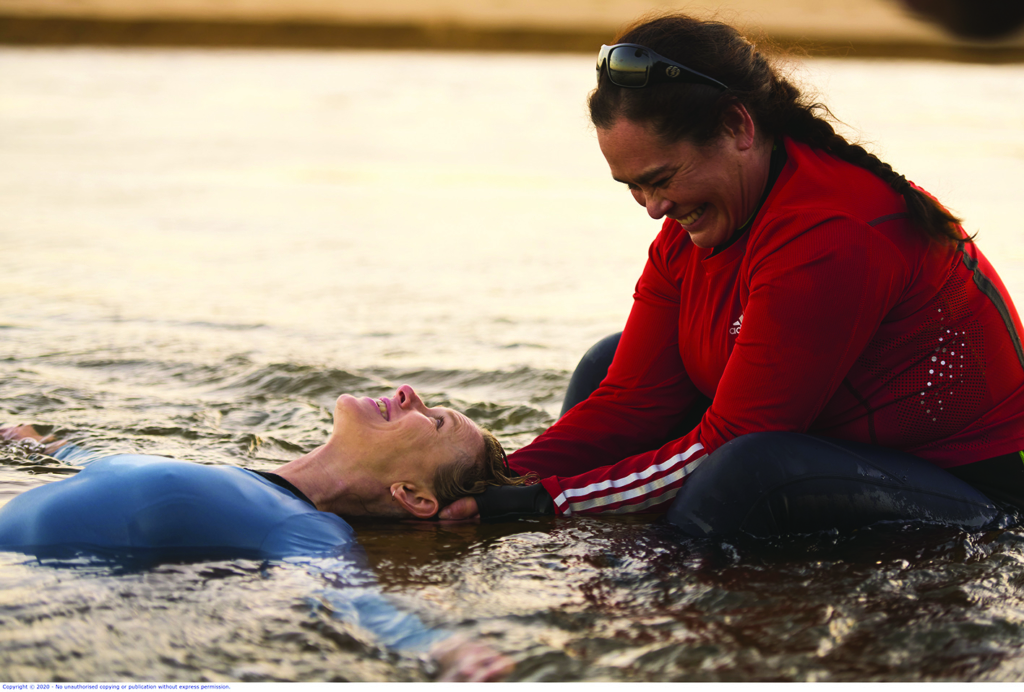
Practically, this free, observational approach meant that the magpies playing Penguin took the film in unexpected directions. ‘[They] drove nearly every scene,’ says Ivin.
Quite often, we’d start with [one of the magpies], where he wanted to be, and start shooting – and then he’d decide he wanted to be in every other corner of the room, so we’d have to move. In that way, we were constantly relying on him as he went along, and making the film up as we went along!
For example, in the scene where Samantha smashes all the photos, he plays a really important role, but he wouldn’t do the same thing twice – not even remotely would he do anything twice – which meant we had to shoot, then reshoot. I really liked that process, because it meant Penguin was driving the scene, rather than us shooting what we’d written and planned months before.
Another element that injected unpredictability into the filmmaking was having three children on set. Ivin has worked extensively with children: his short film Cracker Bag (2003), set in an inland country town in Australia in the 1980s, recounts cracker night from the viewpoint of a girl with separated, warring parents; while his debut feature film, The Last Ride (2009), follows a violent criminal on the run with his ten-year-old son, and their troubled relationship as they travel through the outback. Ivin says,
Children see the world from an innocent, naive perspective, and, in that way, they are the perfect vessel for telling a story. When a child looks at something, you know that they are looking at it for the first time – without life experience or context to give it meaning. I also like the randomness of having children on set, and the challenge of shaking a story out of them. They’re incredibly innate actors.
I’ve always enjoyed observational documentaries, where there isn’t much dialogue or narration. Instead, the filmmaker relies on the audience to participate.
Glendyn ivin
Although much of Penguin Bloom captures Sam’s perspective, it is her son Noah whose narrative frames the film. His voice dips and weaves in and out of the action, providing another perspective on events – and, ultimately, playing a role, like Penguin, in her healing process.
Penguin Bloom is, on the one hand, a film about the emotional evolution of a woman and her family following a devastating accident. On the other, it is an exploration of the relationship between humankind and nature – about both the inextricability of that dynamic and its power to heal, through the primacy of instinct and the unpredictability of the untamed. In stripping the story back to its essence and inviting wildness into the filmmaking process, its director has created a poignant, unified and visually beautiful work that feels like part observational documentary and part high human drama.
Endnotes
| 1 | See Gail Williams, ‘The Inspirational Story of How Penguin the Magpie Saved Sam Bloom After a Horrendous Fall’, Sunday Times Magazine, 26 February 2018, available at <https://www.perthnow.com.au/lifestyle/stm/stm-the-inspirational-story-of-how-penguin-the-magpie-saved-sam-bloom-after-a-horrendous-fall-ng-b88749362z>, accessed 17 March 2021. |
|---|---|
| 2 | Penguin is played in the film by eight different magpies; see Melissa Maykin, ‘Penguin Bloom Bird Trainer Paul Mander Is the Man Behind the Film’s Much-loved Magpie’, ABC News, 5 February 2021, <https://www.abc.net.au/news/2021-02-05/bird-trainer-paul-mander-behind-penguin-bloom-movie/13122094>, accessed 22 February 2021. |
